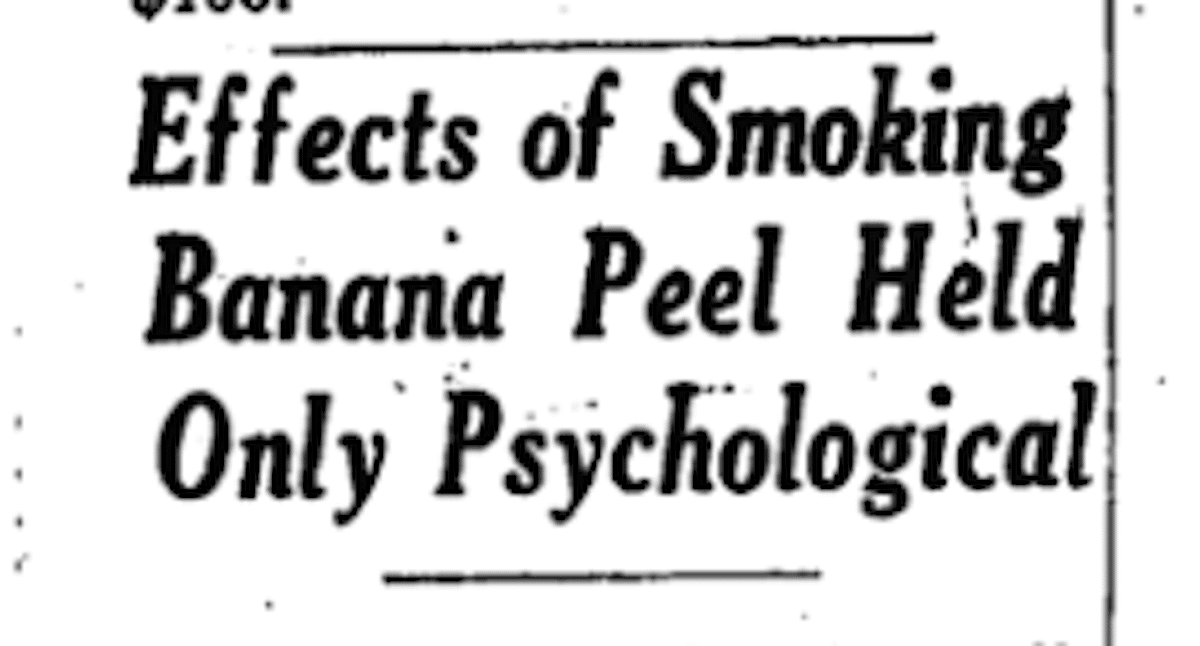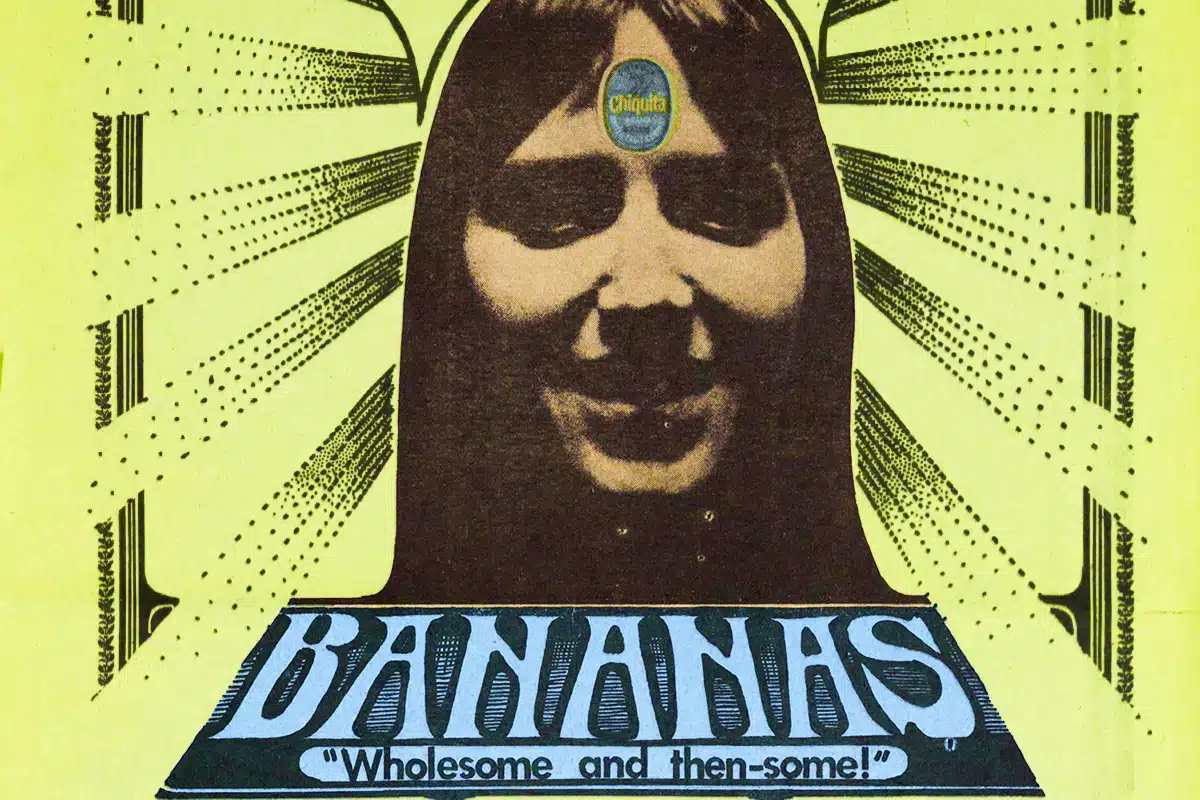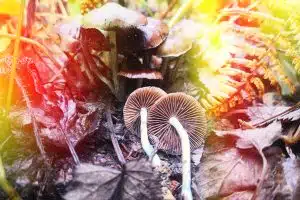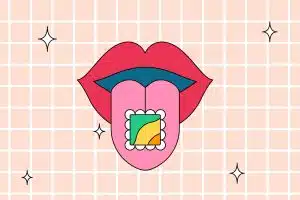It sounds like something out of an SNL skit. “They call it souping—kids are drinking expired soup cans to get high. Every teenager is doing it, and it will kill them!” Bill Hader quipped in a 2013 sketch parodying the news’ obsession with “frightening teen trends.” It seems like every year, the media fixates on a new, imagined threat to youth, often something they’re doing “to get high.”
It turns out, these kinds of drug-related myths have been circulating for decades. In 1967, the New York Times published an article claiming that smoking banana peels was “the latest craze among college students and beatniks,” who were pursuing a high reminiscent of that of cannabis. Four months later, another Times article claimed that hippies smoked banana peels at the invocation of marijuana protest “smoke-ins” on Manhattan’s Lower East Side, though by the end of the year, the paper was citing research that found no evidence of any hallucinogenic compounds in banana peels, concluding that any high obtained was likely a placebo. Within a few years, reporting on people smoking banana peels—and the alleged psychoactive compound they supposedly contained, “bananadine”—had all but disappeared. As it was a passing fad? A political statement? There’s a reason you won’t find any trip reports for bananadine on Erowid.
Bananadine: The Psychedelic That Wasn’t
First, we’ll say this: the only way to trip on a banana peel is by slipping on one. “Bananadine” does not exist: It’s entirely fictional. Banana peels—whether raw, smoked, or baked—are not psychedelic. Still, by the late 1960s, the “hallucinogenic” fruit skin was making headlines in some of the world’s most prestigious newspapers: The New York Times, Time, and Newsweek.
Frank Thompson, a Democratic New Jersey Congressman, introduced the “Banana and Other Odd Fruit Disclosure and Reporting Act of 1967,” seeking to take firm federal action against the recreational use of bananas by labeling them with some sort of “no smoking” sticker.
READ: Why Are Shrooms Illegal?

“Apparently, it was not enough for this generation of thrill-seekers to use illicit LSD, marijuana, and airplane glue. They have now invaded the fruit salad,” he testified to the House of Representatives on April 19, 1967. “What can Congress do in this time of crisis? A high official in the FDA has declared: ‘Forbidding the smoking of materials from banana peels would require congressional legislation.’ […] As a legislator, I feel it is my duty to respond to this call of action.”
The federal Food and Drug Administration announced it was investigating banana peels as a possible psychedelic. Smoking them, they thought, might produce “the methylated form of serotonin.” At the time, methylated serotonin was also studied for its connection to schizophrenia.
How to Grow Shrooms Bundle
Take Both of Our Courses and Save $90!
That same year, New York University medical researchers surveyed 50 people who had smoked banana peels and found that twelve saw no effects and thirteen noticed only subtle changes. The other half reported effects ranging from sedation to elevated mood, with only three explicitly experiencing hallucinogenic sensations that some compared to the effects of DMT. However, the researchers’ chemical analysis found that unsmoked peels contained no DMT, and baked peels were capable of producing only mild effects on the nervous system, which users might psychologically “elaborate” into the perception of a high. Put differently, anyone who felt high after smoking banana peels was likely experiencing placebo, motivated by their personal desires or rumors they had heard.Eventually, the FDA’s research also failed to find any evidence of psychoactivity. “A laboratory apparatus ‘smoked’ dried banana peels for more than three weeks and never did get high,” they wrote in a news release. The conclusion was plain: banana peels are not hallucinogenic.
The Great Banana Hoax
So—what gives? We’ll have to set the scene. In the 1960s, at the height of the counterculture movement, people experimented with all kinds of substances, from LSD to marijuana to peyote. In this atmosphere of exploration, some looked to household staples like cloves and poppy seeds as possible exciting new drugs.
This environment went hand-in-hand with a strange confluence of misinterpreted song lyrics, imaginative musicians, underground news reports, and a plethora of reprinted “recipes.” The air was ripe for misinformation.
Author John McMillian explores this experimental landscape in his book Smoking Typewriters, which looks at the influence of the American alternative press in the 1960s. Prior to the internet, underground presses were a primary means of communicating counterculture news. There was the Los Angeles Free Press, the NY East Village Other, and, of course, the first known culprit to propagate the banana myth: the Berkeley Barb.
These underground newspapers challenged the mainstream media’s assumptions about culture and national issues. But, rumors could easily circulate unchecked. On March 17, 1967, the Barb wrote that baking banana peels caused a chemical reaction that created bufotenine, the same psychoactive compound secreted by the Sonoran Desert Toad—and hardly a mild one. Eventually, the story of bufotenine transformed into the story of bananadine through a twisted game of telephone. Baked banana peels contain neither compound.
READ: 57 Greatest Psychedelic Quotes of All Time

Groups held banana sit-ins, advertised by the underground press. Psychedelic entrepreneurs schemed up business opportunities. One business hopeful, Lary Starin, told the Barb that his venture “will provide jobs for hippies, with modest pay, free hot lunches and all the bananas they can eat. Those who buy ‘nickel bags’ of prepared banana scrapings will be happy, too.”
Today, our “bird’s eye view” of the situation makes it clear that the idea of smoking banana peels—while inevitably attempted by numerous people who heard the rumor—was a joke. Or, as the FDA loudly exclaimed: a hoax. Although, whether or not the hoax was intentional is the subject of rumor.
According to McMillian, the hoax began with the psychedelic rock band Country Joe and the Fish. As the story goes, the band started smoking banana peels after drinking from a pitcher of water that also happened to contain one hundred tabs of dissolved LSD. Smoking banana peels wasn’t completely out of character for the band. Drummer Gary “Chicken” Hirsh made a hobby of experimenting with different plants that might contain psychoactive compounds—or so he believed. Following Hirsh’s hunch, the band had prepared banana scrapings earlier in the day to test out. Word got out at their show.
Barb columnist Ed Denson was the band’s manager.
Then things went mainstream. The idea took off, and many people associated it with Scottish singer Donovan’s 1966 song “Mellow Yellow,” which was believed to be about smoking banana peels. (In fact, Donovan wrote in liner notes accompanying his 1969 greatest hits album that the “electrical banana” mentioned in the song was actually a coded reference to vibrators.)

Within a year of the rumor’s appearance, the federal government was already investigating whether bananas could be turned into drugs. Within a larger atmosphere of fear-mongering around “reefer madness” (a term coined by a 1936 anti-marijuana propaganda film), some anti-drug organizations may have contributed to spreading the banana peel myth as a way to frighten young people away from experimenting with drugs.If the New York Times’ and other reporting holds water, certain people actually did smoke banana peels, but in most cases this was likely as a joke, or to achieve minor, non-hallucinogenic effects—smoking anything can give you a buzz.
The Bananadine “Recipe”
The supposed culprit behind banana peels’ high was a psychoactive compound called “bananadine,” which does not actually exist. It’s a made-up name for a made-up substance. There is no scientific evidence to suggest that any part of the banana plant contains compounds that could cause hallucinations or other serious drug-like effects.

Nonetheless, a recipe for smoking banana peels appeared in the Berkeley Barb. Citing dubious research, the article claimed that the best way to smoke banana peels was to first freeze them, then blend them into a pulp before baking them at 200 degrees and finally smoking them in a cigarette or pipe. “Banana Sunshine!” declared the article, which was reprinted in newspapers from Los Angeles, to Seattle, Detroit, Austin, and New York.
Likely believing the half-baked article to be true, countercultural author William Powell included a similar recipe for producing “bananadine” in his 1971 book The Anarchist Cookbook, which along with other controversial content included instructions for producing explosives, weapons, and illicit drugs like LSD at home. (After numerous perpetrators of violent incidents were found to have been interested in his cookbook, Powell himself later joined calls for publishers to cease printing it, though it has never gone out of publication, and more than two million copies have been sold.)
Once again, “bananadine” is not—nor has ever been—a real compound. We do not recommend attempting this recipe, nor anything else from The Anarchist Cookbook!
Conclusion
Regardless of the reasons behind the myth, it’s important to set the record straight. Banana peels are not hallucinogenic, and there is no such thing as bananadine. If you’re looking for a psychedelic experience, there are plenty of legal and safe ways to do so. But smoking banana peels is not one of them.
At the same time, there is something funny about how easily and quickly this hoax provoked reactions from the government and mainstream media, who at the time were quick to demonize any and all emerging psychedelics, proving the hippies’ point: that drug panic was often misguided, motivated more by fear and lies than by actual scientific evidence. MDMA does not take ice cream scoops out of your brain, LSD trips do not last forever, and “the kids” are not actually smoking banana peels—nor are they drinking expired soup cans to get high, or “trampolining,” another term confabulated by that SNL skit.

DoubleBlind is a trusted resource for news, evidence-based education, and reporting on psychedelics. We work with leading medical professionals, scientific researchers, journalists, mycologists, indigenous stewards, and cultural pioneers. Read about our editorial policy and fact-checking process here.

DoubleBlind Magazine does not encourage or condone any illegal activities, including but not limited to the use of illegal substances. We do not provide mental health, clinical, or medical services. We are not a substitute for medical, psychological, or psychiatric diagnosis, treatment, or advice. If you are in a crisis or if you or any other person may be in danger or experiencing a mental health emergency, immediately call 911 or your local emergency resources. If you are considering suicide, please call 988 to connect with the National Suicide Prevention Lifeline.



